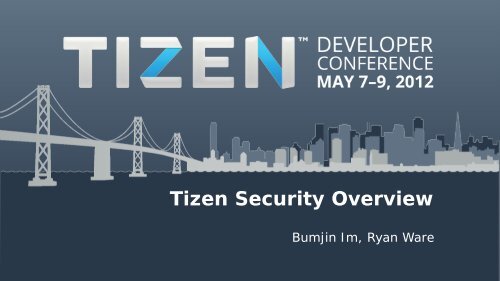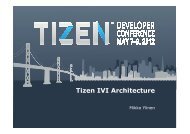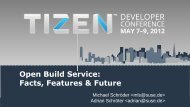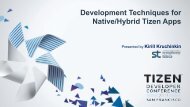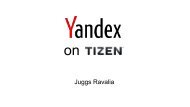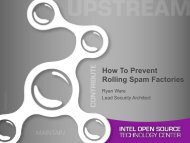Tizen Security Overview
Tizen Security Overview
Tizen Security Overview
- No tags were found...
You also want an ePaper? Increase the reach of your titles
YUMPU automatically turns print PDFs into web optimized ePapers that Google loves.
<strong>Tizen</strong> <strong>Security</strong> <strong>Overview</strong>Bumjin Im, Ryan Ware
Contents• <strong>Security</strong> Model of <strong>Tizen</strong>• Enforcing Access Control– Kernel space access control by Smack– User space access control• Application <strong>Security</strong>– Package Signing– Manifest Permission• Future Plans2tizen.org
TIZEN SECURITY MODEL3tizen.org
<strong>Tizen</strong> Threat ModelFake / unauthorizedapp storeDistributeunauthorized/malicious appAuthorizedapp storeStandard Linux Threats<strong>Tizen</strong> ThreatsDistributeUnauthorized appDownloadunauthorized/Malicious appDownloadmalicious appRegistermalicious appSDKUser/developer(maybe malicious)Modify,unlock,replaceCopy protectedcontentsModify(crack) appGet unauthorizedinformationApplication(maybemalicious)Callunauthorized APIPlatform / resourcesSteal app dataExploitInternetExploitSteal user dataHacker(malicious)<strong>Tizen</strong> device4tizen.org
High Level <strong>Security</strong> Principles• No application running under root privilege– Most system daemons currently running under root privilege• Will be minimized soon• No application can interrupt each other– Applications are sandboxed– Also possible to have application family• Important system resources are protected by access controlmechanism– Kernel space objects: DB files, network interface, IPCs, signals, …– User space objects: Make phone call, Send SMS, …• All applications should have least privilege– Each application has different set of privileges5tizen.org
<strong>Security</strong> Model• Non root applications– All applications run under same non-root user ID– Most of the middleware daemons will run as non-root user• Application sandboxing– All applications are sandboxed by Smack• Each application has its own Smack label– Each application unable to send IPC and signal, r/w other application files, …• Resource access control– Important system objects are Smack labeled– System daemons will make use of Smack and enforce access control– All files owned by root• Applications only able to write to home directory• Least privilege– All applications will have manifest file describing permissions• Manifest file describes SMACK labels and rule of the application to get proper privileges6tizen.org
ACCESS CONTROL8tizen.org
Smack• <strong>Tizen</strong> includes the Simple Mandatory Access Control Kernel(Smack)– Upstream Linux <strong>Security</strong> Module– Simple {subject, object, permission} access control model– Provides method of creating appropriate security domains withoutwholly understanding a 900,000 line reference policy• New Features:– Long Label Support• Smack labels up to 255 characters instead of 23– Recursive Transmute• Isolation of application tmpfs contents– SmackFS Access• Mechanism allowing userspace apps to check Smack permissions9tizen.org
Smack Enabled Services• Xorg– X Access Control Extension• DBus– Utilizes SmackFS Access– Allows DBus to enforce Smack protections itself• Udev• RPM– Create device nodes with Smack labels– <strong>Security</strong> Manifest Plugin– Sets Smack Labels on Install10tizen.org
User Space Access Control• User Space Objects– System resources consist of client-server• Use IPC for request/response channel & access occurs in server side– i.e) telephony, network, messaging, email, system f/w, …• Not possible to use kernel space access control• Mechanism– Direct IPC: Server identifies client by kernel feature (SO_PEERSEC)• Check Smack rule for client label and continue service– Indirect IPC:• Trusted Daemon (security-server) identifies client and issues random cookie– Cookie identifies a Smack label– <strong>Security</strong> of the cookie value is important– Need garbage collection mechanisms for closed processes• Client uses cookie with request and server checks cookie with security server• Can be used as service with single DBus interface as IPC for multiple services11tizen.org
User Space Access Control (cont)5. Request service with cookie1. Request serviceApplication ProcessIntermediateprocessService daemonApplicationProcessServicedaemon9. Service responds3. Service responds1. Requestcookie4. Cookie8. Returnresult6. Ask privilegewith given cookie2. Get Client PID3. Generate random cookie<strong>Security</strong> Server2. Check SMACK rules7. Check SMACK rulesSMACK rulesIn-direct IPC caseSMACK rulesDirect IPC case12tizen.org
APPLICATION SECURITY13tizen.org
Manifests• Included as part of packageA new label for labelling camera statisticdataA new label for labelling camera data that containsinformation about timingsA new label for labelling camera publicdata14tizen.org
Secure Software Distribution• Ensure SW updates originate from any one of multipleauthenticated sources– RPM Signed Updates• Trust Levels Assigned to Sources– Updates for installed software can only come from the samesource or a source with higher trust• OEM configurable• Remotely updateable15tizen.org
Conclusion & QA• <strong>Tizen</strong> Cannot Be Secure Without Your Help!!!– We can’t have eyes everywhere!• If you have a security concern of any kind:– security@tizen.org• There will be opportunities to participate in <strong>Tizen</strong> securitysoon16tizen.org


